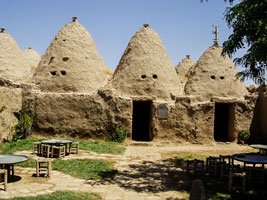Harran (Altınbaşak, i.e. Golden Corn Ear), with its famous mud-brick beehive houses, is located at about 45 km southeast of Urfa.
History of Harran
Harran is one of the oldest continuously inhabited spots on earth.
It first came to prominence under the Assyrians who made it a centre for the worship of Sin, the god of the moon. The Bible (Genesis 11:31, 11:32, 12:4) names Harran or Haran as the place where Terah and his son Abram (Abraham, Ibrahim) and his grandson Lot stayed when they fled from Ur of the Chaldees. Abraham's father Terah died in Haran (Genesis 12:4).
Haran rebelled against its Assyrian rulers and this too is mentioned in the Bible (2 Kings 19:12, Isaiah 37:12). Later, in Roman times Harran was known as Carrhae and was the place of the famous Battle of Carrhae in which the Roman Emperor Marcus Licinius Crassus was defeated by the Parthians. In early Islamic times, Harran was one of the major cities of the region and was a centre for translating works of astronomy, philosophy, natural sciences, and medicine from Greek into Syriac and thence into Arabic.
Sights and Photos of Harran
Harran is most famous for its mud-brick beehive houses, the design of which goes back to the 3rd century BCE and are unique to Turkey. However, similar houses can be seen in Syria. In addition to these beehive houses, there are the ruined walls, the Ulu Cami and the crumbling fortress that all add up to give the place a feeling deep antiquity. The remains of the fortress (Kale) date back from after 1059 when the Fatimids restored the original buildings. It is thought that a castle was already standing here from Hittite times.
At about 26 km east from Harran are the ruins of the Han El Ba'rur a Seljuk caravanserai that dates back to 1128. Another 12 km northeast of Han El Ba'rur is the ruin-city of Şuayb, an ancient, partially subterranean, town where once the prophet Jethro lived. From Şuayb it is 18km north to reach the site of the ancient Soğmatar (also called Sumatar), a Sabian place of worship for the moon god Sin from about CE 150 to CE 200.
https://turkeyphotoguide.com/harran?tmpl=component&print=1#sigProId26905f4384
Travel Information & Travel Tips
Driving east from Harran is difficult, at least it was in 2002 since the road here have no signage at all and the landscape lacks any variety. We took an organized tour from Urfa. However, even our Kurdish driver and his companion guide got terribly lost driving around here.






















